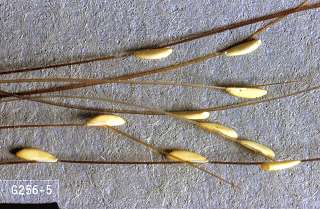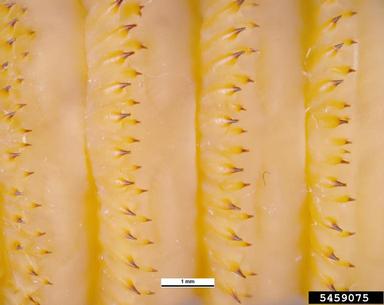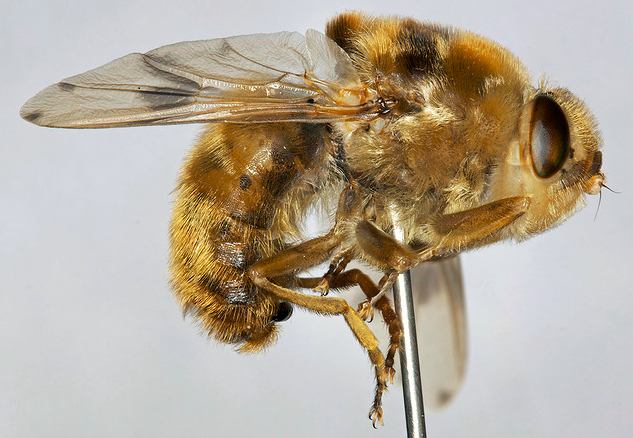Form & Function
Gastrophilis intenstinalis has a lot of adaptations through its life cycle to keep it close to its host, literally!
The eggs of the fly have a long, lean, small formation that can be found on the individual hairs of the horses. The eggs are yellowish white in color (Agricultural Research Service, 1920). Horse bot flies lay their eggs on the forelegs of their hosts. Overtime, the eggs develop and cause irritation to the horse. The horse licks the area, and transfers the newly born larvae from the egg to the mouth. The delayed, stimuli-regulated hatching is how the larvae make sure they get to the place where they need to go, the stomach. Ken Gray Image Courtesy of Oregon State University
The larvae have a 3-staged life period, called instars. First
instar larvae spend its time in the mouth, either in the gums or in
the tongue. After a few weeks, they molt and move onto their second
stage; and they move to the stomach (McLen don and Kaufman, 2007).The larval
don and Kaufman, 2007).The larval
.jpg) mouth is adapted to secure itself to the stomach lining
with a hook like structure on its mouthparts (McLendon and Kaufman,
2007). This is how it keeps itself in place for the time it spends
in the stomach. During this time it changes from a second instar to
a third instar larva. At this point, the larvae have grown in size
from ½ inch to ¾ inch long (McLendon and Kaufman, 2007). They have
spines along their body to help them stay in place with and
contractions or movement that occur.
mouth is adapted to secure itself to the stomach lining
with a hook like structure on its mouthparts (McLendon and Kaufman,
2007). This is how it keeps itself in place for the time it spends
in the stomach. During this time it changes from a second instar to
a third instar larva. At this point, the larvae have grown in size
from ½ inch to ¾ inch long (McLendon and Kaufman, 2007). They have
spines along their body to help them stay in place with and
contractions or movement that occur.
Pest and Diseases Image Library, Bugwood.org Pest and Diseases Image Library, Bugwood.org
The larvae’s exoskeleton help protect itself from the gastric acid, that have a pH ranging from 2.3 to 3.5. The third instar larvae are distinguished by its yellow color (McLendon and Kaaufman, 2007). Once the larvae have matured, they detach and move out of the horse through its feces.The larvae now enter a pupation period and spend about a month or two in the soil or old feces. The number of pupae in a waste pile is extremely large because horses fail to release their waste in different places (McLendon and Kaufman, 2007). The body of the pupae hardens and acts like a cocoon, until the fully grown adult horse bot fly emerges in the summer season. The close proximity of the emerging adult helps for quick aggregation and reproduction.
The larvae now enter a pupation period and spend about a month or
two in the soil or old feces. The number of pupae in a waste pile is
extremely large because horses fail to release their waste in
different places (McLendon and Kaufman, 2007). The body of the pupae
hardens and acts like a cocoon, until the fully grown adult Horse
Bot Fly emerges in the summer season. The close proximity of the
emerging a dult
helps for quick aggregation and reproduction.
dult
helps for quick aggregation and reproduction.
The body of G. intestinalis closely resembles that of a honey bee or a fly. Its body is separated into three sections; which are a head, a thorax, and an abdomen. They have a pair of compound eyes for its tool of vision. These eyes have a wide range of vision and dual image vision (Olsen, 2002), which help its rigorous search for a horse. These are traits are what classifies it as an insect. It moves through the air by a pair metathoracic wings. This is what classifies it as a true fly (Order - Diptera). The bot fly’s wing are capable to reach speeds of 50 miles per hours (Encyclopedia Britannica, 2014), which is fast enough to catch horses is dead sprint. This adaptation is a great advantage, as it can help G. intestinalis in the chase of its host.
Photo taken by Michael Jefferies
When the fly tries to lay eggs on the horse, the horse becomes scared and tries to escape the incoming assault. G. intenstinalis females can chase after the horse and match its speed, and can continue to plant its eggs on the horse (Cogley and Cogley, 2000). The mouthpart of the fly, however, isn’t functional at all. Adult flies cannot feed or bite anything, as the mouth is sealed shut (McLendon and Kaufman, 2002. Cogley and Cogley, 2000).
Isn't it cool how these features have been selected for overtime! You know what else is cool? The life cycle of the horse bot fly!
Want to go home?